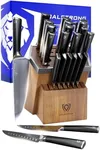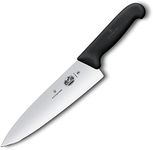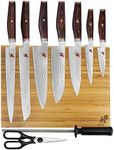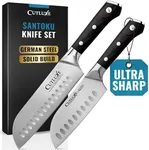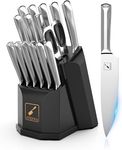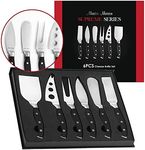Buying Guide for the Best Kitchen Knives
Choosing the right kitchen knife can significantly enhance your cooking experience. A good knife should feel comfortable in your hand, be well-balanced, and suit the tasks you perform most frequently in the kitchen. Understanding the key specifications of kitchen knives will help you make an informed decision and select the best knife for your needs.Blade MaterialThe blade material of a kitchen knife affects its sharpness, durability, and ease of maintenance. Common materials include stainless steel, carbon steel, and ceramic. Stainless steel is resistant to rust and easy to maintain, making it a popular choice for everyday use. Carbon steel is known for its sharpness and edge retention but requires more care to prevent rust. Ceramic blades are extremely sharp and lightweight but can be brittle and prone to chipping. Choose a blade material based on your willingness to maintain the knife and your preference for sharpness and durability.
Blade LengthBlade length determines the knife's versatility and suitability for different tasks. Common lengths range from 6 to 12 inches. Shorter blades (6-8 inches) are easier to control and ideal for tasks like chopping vegetables and slicing small fruits. Medium blades (8-10 inches) offer a balance of control and versatility, suitable for most kitchen tasks. Longer blades (10-12 inches) are great for slicing large cuts of meat and bread but can be harder to handle. Consider the types of food you prepare most often and choose a blade length that matches those tasks.
Handle MaterialThe handle material affects the knife's comfort, grip, and durability. Common materials include wood, plastic, and composite. Wooden handles offer a traditional look and comfortable grip but require more maintenance to prevent damage from moisture. Plastic handles are durable, easy to clean, and often have a textured surface for a secure grip. Composite handles combine the benefits of wood and plastic, providing durability and comfort. Choose a handle material that feels comfortable in your hand and suits your maintenance preferences.
Blade EdgeThe blade edge determines the knife's cutting performance and maintenance needs. Common edge types include straight, serrated, and granton. Straight edges are versatile and easy to sharpen, making them suitable for most tasks. Serrated edges are ideal for cutting through tough or crusty surfaces, like bread, but can be harder to sharpen. Granton edges have small indentations that reduce friction and prevent food from sticking to the blade, making them great for slicing. Consider the types of food you cut most often and choose a blade edge that matches those tasks.
Weight and BalanceThe weight and balance of a kitchen knife affect its ease of use and comfort. A well-balanced knife feels stable and comfortable in your hand, reducing fatigue during extended use. Heavier knives provide more cutting power and are suitable for tasks like chopping dense vegetables or meat. Lighter knives offer better control and are ideal for precision tasks like slicing herbs or filleting fish. Test the knife in your hand to see how it feels and choose one that offers a comfortable balance for your preferred cooking tasks.
